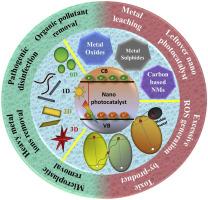Advances in powder nano-photocatalysts as pollutant removal and as emerging contaminants in water: Analysis of pros and cons on health and environment
引用次数: 0
Abstract
Photocatalysis is an advanced oxidation process where light exposure triggers a semiconducting nanomaterial (nano-photocatalyst) to generate electron-hole (e−/h+) pairs and free radicals. This phenomenon is widely used for the photocatalysis-assisted removal of organic and other contaminants using wide range of nano-photocatalysts, offering an efficient approach to environmental remediation. However, the introduction of powdered nano-photocatalysts into water systems often leads to unintended secondary pollution in the form of residual nano-photocatalysts, ion leaching, free radicals, toxic by-products etc. Such practices potentially introduce emerging secondary contaminants into aquatic environments, posing risks to both aquatic life and human health. The resulting chemical by-products and intermediates can effectively induce chronic toxicity, neurological and developmental disorders, cardiovascular defects, and intestinal ailments in humans and aquatic species. Despite having a range of health and environmental consequences, this dark side of nano-photocatalysts has been comparatively less explored and discussed in the literature. In this review, the pros and cons of powder nano-photocatalysts are discussed in view of their advantages as well as disadvantages in wastewater treatment. The discussion encompasses their classification based on composition, dimensions, structure, and activity, as well as recent advancements in improving their photocatalytic efficiency. The article also explores the recent advances on their applications in photocatalytic removal of various water pollutants/contaminants of emerging concern (i.e., organic pollutants, micro/nano plastics, heavy ions, disinfections, etc.) Furthermore, an emphasis on the role of such nano-photocatalysts as emerging (secondary) contaminants in water system, along with a thorough discussion of latest studies related to the health and environmental issues, has been discussed. Additionally, it addresses critical issues in applying powder nano-photocatalysts for wastewater detoxification and explores potential solutions to these challenges followed by future prospects.

粉末纳米光催化剂在去除污染物和作为水中新污染物方面的进展:健康与环境利弊分析
光催化是一种先进的氧化过程,在这一过程中,光线照射会触发半导体纳米材料(纳米光催化剂)产生电子-空穴(e-/h+)对和自由基。这种现象被广泛用于光催化辅助去除有机物和其他污染物,使用的纳米光催化剂种类繁多,为环境修复提供了一种有效的方法。然而,将粉末状纳米光催化剂引入水系统往往会导致纳米光催化剂残留、离子沥滤、自由基、有毒副产品等形式的意外二次污染。这种做法可能会将新出现的二次污染物引入水生环境,对水生生物和人类健康构成风险。由此产生的化学副产品和中间体可有效诱发人类和水生生物的慢性中毒、神经和发育障碍、心血管缺陷和肠道疾病。尽管纳米光催化剂具有一系列健康和环境后果,但文献中对其阴暗面的探讨和讨论相对较少。本综述从纳米粉末光催化剂在废水处理中的利弊两方面进行了讨论。讨论内容包括根据成分、尺寸、结构和活性对其进行的分类,以及在提高其光催化效率方面的最新进展。文章还探讨了纳米光催化剂在光催化去除各种水污染物/新出现的污染物(如有机污染物、微/纳米塑料、重离子、消毒剂等)方面的最新应用进展。此外,文章还重点讨论了此类纳米光催化剂作为水系统中新出现的(二次)污染物的作用,并深入探讨了与健康和环境问题相关的最新研究。此外,报告还讨论了将粉末纳米光催化剂用于废水解毒的关键问题,并探讨了应对这些挑战的潜在解决方案以及未来前景。
本文章由计算机程序翻译,如有差异,请以英文原文为准。
求助全文
约1分钟内获得全文
求助全文

 求助内容:
求助内容: 应助结果提醒方式:
应助结果提醒方式:


